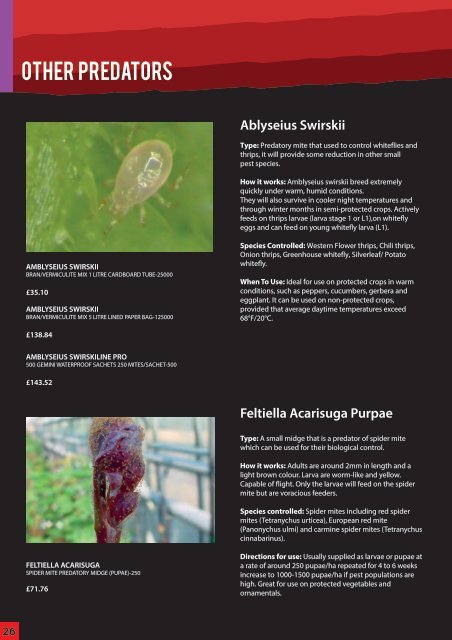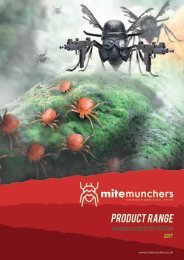MM Catalog 2017
You also want an ePaper? Increase the reach of your titles
YUMPU automatically turns print PDFs into web optimized ePapers that Google loves.
other predators<br />
Ablyseius Swirskii<br />
Type: Predatory mite that used to control whiteflies and<br />
thrips, it will provide some reduction in other small<br />
pest species.<br />
How it works: Amblyseius swirskii breed extremely<br />
quickly under warm, humid conditions.<br />
They will also survive in cooler night temperatures and<br />
through winter months in semi-protected crops. Actively<br />
feeds on thrips larvae (larva stage 1 or L1),on whitefly<br />
eggs and can feed on young whitefly larva (L1).<br />
AMBLYSEIUS SWIRSKII<br />
BRAN/VERMICULITE MIX 1 LITRE CARDBOARD TUBE-25000<br />
£35.10<br />
AMBLYSEIUS SWIRSKII<br />
BRAN/VERMICULITE MIX 5 LITRE LINED PAPER BAG-125000<br />
Species Controlled: Western Flower thrips, Chili thrips,<br />
Onion thrips, Greenhouse whitefly, Silverleaf/ Potato<br />
whitefly.<br />
When To Use: Ideal for use on protected crops in warm<br />
conditions, such as peppers, cucumbers, gerbera and<br />
eggplant. It can be used on non-protected crops,<br />
provided that average daytime temperatures exceed<br />
68°F/20°C.<br />
£138.84<br />
AMBLYSEIUS SWIRSKILINE PRO<br />
500 GEMINI WATERPROOF SACHETS 250 MITES/SACHET-500<br />
£143.52<br />
Feltiella Acarisuga Purpae<br />
Type: A small midge that is a predator of spider mite<br />
which can be used for their biological control.<br />
How it works: Adults are around 2mm in length and a<br />
light brown colour. Larva are worm-like and yellow.<br />
Capable of flight. Only the larvae will feed on the spider<br />
mite but are voracious feeders.<br />
Species controlled: Spider mites including red spider<br />
mites (Tetranychus urticea), European red mite<br />
(Panonychus ulmi) and carmine spider mites (Tetranychus<br />
cinnabarinus).<br />
FELTIELLA ACARISUGA<br />
SPIDER MITE PREDATORY MIDGE (PUPAE)-250<br />
£71.76<br />
Directions for use: Usually supplied as larvae or pupae at<br />
a rate of around 250 pupae/ha repeated for 4 to 6 weeks<br />
increase to 1000-1500 pupae/ha if pest populations are<br />
high. Great for use on protected vegetables and<br />
ornamentals.<br />
26











